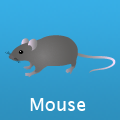cytochrome P450, family 1, subfamily a, polypeptide 2 |
jump to detail |
Synonym
P450-3, Cytochrome P450 1A2, aromatic compound inducible, CYPIA2, CP12, Cyp1a2, Cyp1a-2, P450-P2/P450-P3
| Refseq ID | NM_009993 |
|---|---|
| Gene ID | 13077 |
| Unigene ID | Mm.15537 |
| Probe set ID | 1450715_at [Mouse430_2] |
| Ensembl ID | ENSMUSG00000032310 |
| - |
| IPR001128 | Cytochrome P450 |
| IPR002401 | Cytochrome P450, E-class, group I |
| IPR008066 | Cytochrome P450, E-class, group I, CYP1 |
| IPR002403 | Cytochrome P450, E-class, group IV |
1313028
1335375
1452456
1794054
1794058
1889815
2425809
2505256
2512252
2572508
2576007
2885918
3718958
3755821
3785172
3860967
3988744
4040754
4054433
6262772
6324134
6328503
6421814
6547952
6548461
7490103
7508708
7750163
7761462
7781742
8001243
8137279
8215422
8274012
8297798
8406508
8486527
8486528
8499946
8507983
8643688
8795463
8954808
9119402
9128719
9143510
9226375
9240455
9295056
9441766
9461503
9464455
9559668
9585423
9615220
9772215
9784916
9875304
10094576
10445756
10448125
10503904
10570017
10623596
10631128
11003706
11043581
11141507
11198052
11217851
11274970
11384210
11915039
12372429
12398935
12438513
12464254
12466851
12477932
12745259
12958197
14637164
14681479
14980704
15003330
15028720
15094312
15252868
15329440
15489334
15643613
15752708
15845371
16183037
16377763
16516144
16636061
16684708
16876762
16916647
17052995
17166882
17560947
17569574
17997381
18372398
18722179
18814841
19261855
19285097
19370779
19520064
19695277
20118626
20164109
21081470
21571617
21880518
22086975
22260863
22935098
22982977
23776235
23956430
24349309
1335375
1452456
1794054
1794058
1889815
2425809
2505256
2512252
2572508
2576007
2885918
3718958
3755821
3785172
3860967
3988744
4040754
4054433
6262772
6324134
6328503
6421814
6547952
6548461
7490103
7508708
7750163
7761462
7781742
8001243
8137279
8215422
8274012
8297798
8406508
8486527
8486528
8499946
8507983
8643688
8795463
8954808
9119402
9128719
9143510
9226375
9240455
9295056
9441766
9461503
9464455
9559668
9585423
9615220
9772215
9784916
9875304
10094576
10445756
10448125
10503904
10570017
10623596
10631128
11003706
11043581
11141507
11198052
11217851
11274970
11384210
11915039
12372429
12398935
12438513
12464254
12466851
12477932
12745259
12958197
14637164
14681479
14980704
15003330
15028720
15094312
15252868
15329440
15489334
15643613
15752708
15845371
16183037
16377763
16516144
16636061
16684708
16876762
16916647
17052995
17166882
17560947
17569574
17997381
18372398
18722179
18814841
19261855
19285097
19370779
19520064
19695277
20118626
20164109
21081470
21571617
21880518
22086975
22260863
22935098
22982977
23776235
23956430
24349309
Biological Process
Cellular Component
| GO:0005783 | endoplasmic reticulum |
| GO:0043231 | intracellular membrane-bounded organelle |
| GO:0016020 | membrane |





